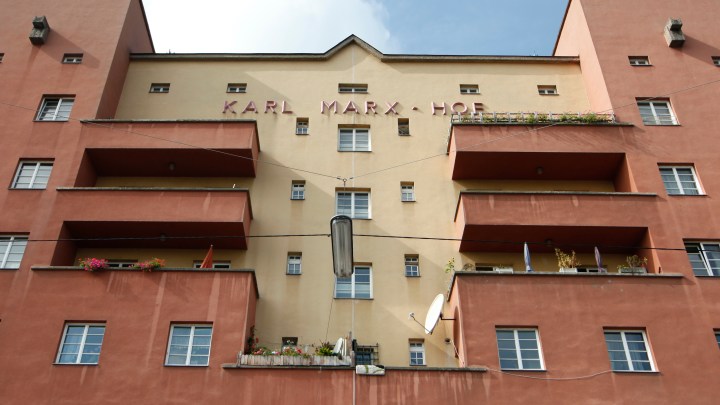
In Vienna, public housing is affordable and desirable

In the U.S., “public housing” might bring to mind buildings in terrible disrepair. But in Austria, many consider public housing, known as social housing, affordable and desirable. Think rooftop swimming pools and saunas, on-site child care, cafes and tennis courts. In Vienna, nearly 3 out of 5 residents live in social housing, and many say that’s one reason the Austrian capital consistently ranks high in quality of life. So how does the city make it work?
Not far from the center of Vienna, city employee Christian Schantl points out a complex of brick-and-concrete apartments, the biggest housing complex in the 3rd District of Vienna.
The city owns these six-story buildings, which have lots of windows, greenery and stone arches. There are courtyards surrounded by tall trees and lined with benches.
“As you see, it’s quite livable, I think,” Schantl said.
Social housing is livable, and it’s available to the middle class. You can earn up to twice the average salary in Vienna and still qualify. The city owns 1,800 apartment complexes. The people who live here include tech workers, retired grandmas, immigrants and middle-class families. Schantl said that is on purpose.
“We have such a social mix within our apartments,” Schantl said.
Most residents pay no more than 25% of their income in rent, including 29-year-old Thomas Fortunits.
“It is like a big dormitory,” Fortunits said. “Sometimes there’s events or having fun together.”
Fortunits said he loves having his own apartment. He doesn’t need roommates, with the rent subsidized. “You can handle it if you want to,” he said.
Vienna’s subsidized housing makes up 44% of the city’s rental stock.

“That’s pretty unique, even by European standards,” said Justin Kadi, a researcher at the University of Technology in Vienna.
He said it drives down rents in the private market. That’s because the city is the biggest landlord. “To some extent, the low rents in the social-housing sector also keep the rents in the private sector low,” Kadi said.
Kadi said social housing is funded by taxes to the tune of 1% of every Austrian paycheck. It adds up to the equivalent of almost $300 million a year for Vienna.
“If you look at how much the city spends, I think it’s also always necessary to look at what it actually gets for it, right?” he said.
And what Vienna gets for it is affordable, high-quality housing that’s available to almost anyone.
There’s a lot happening in the world. Through it all, Marketplace is here for you.
You rely on Marketplace to break down the world’s events and tell you how it affects you in a fact-based, approachable way. We rely on your financial support to keep making that possible.
Your donation today powers the independent journalism that you rely on. For just $5/month, you can help sustain Marketplace so we can keep reporting on the things that matter to you.

















